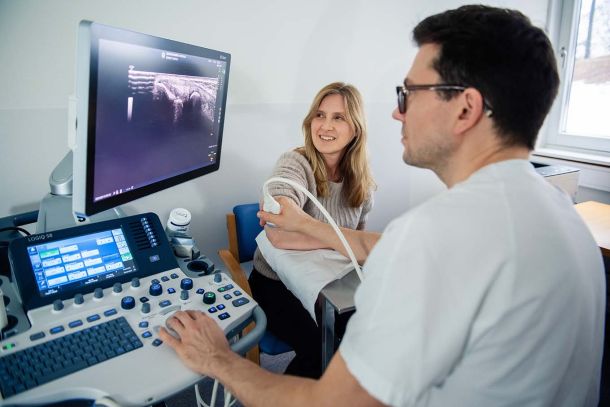New doctorate: High-intensity training for patients with joint diseases

Kristine Røren Nordén has researched how personalized, high-intensity training can improve aerobic capacity in these patients.
Can improved physical fitness help reduce the risk of cardiovascular disease in rheumatic disease?
Nordén describes the new insight in the thesis, Cardiorespiratory fitness in patients with inflammatory joint disease: Associations, validity of assessment and effects of an exercise intervention .
In the picture you see Nordén together with his supervisors. From left, Jonny Hisdal, Kristine Røren Nordén, Hanne Dagfinrud, main supervisor Anne Therese Tveter and Anne Grete Semb. Photo Kathrine Daniloff/Deakonhjemmet hospital
Aerobic capacity and heart health
Aerobic capacity, the body's ability to absorb and use oxygen during physical activity, is an important indicator of general health and strongly linked to the risk of cardiovascular disease. In his PhD, Nordén investigated how aerobic capacity is measured, and how targeted exercise can improve aerobic capacity in patients with inflammatory joint diseases, such as rheumatoid arthritis, spondyloarthritis and psoriatic arthritis.
- Aerobic capacity in patients with rheumatic joint diseases is affected by the same factors as in the general population, such as age, proportion of body fat and level of physical activity. Nevertheless, we see that the level is generally lower in this patient group , says Nordén.
Patients with normal aerobic capacity had a better health profile, including higher levels of "good" cholesterol and better exercise confidence, as well as lower levels of triglycerides, body fat and resting heart rate.
Gold standard for measuring aerobic capacity
She has used the CardioPulmonary Exercise Test (CPET), also known as ergospirometry or cardiopulmonary exercise test, to measure aerobic capacity.
– CPET is the very best tool for measuring aerobic capacity and possible limiting factors in healthy people and patients with varying degrees of heart and lung disease, says Nordén.
She explains that the test makes it possible to adapt the treatment exactly to each individual patient's needs, which is crucial to achieving the best possible health benefits.
Personalized, effective training
In the ExeHeart study, a randomized controlled trial, participants in the exercise group were offered a 12-week high-intensity interval training (HIIT) exercise program. The training was supervised by physiotherapists in the primary health care service. The results showed a significant increase in aerobic capacity after three months. Aerobic capacity was maintained after six months, even after cessation of guided exercise. The exercise program was well tolerated, with no worsening of disease activity.
- It is encouraging that the training was well tolerated without worsening of the disease activity. This shows that HIIT can be a safe and effective treatment method for this patient group, and that this type of exercise can increase aerobic capacity, which is an excellent measure of general health , Nordén explains.
Fitness calculator should be used with caution
In addition to measuring the effect of exercise, the researchers tested fitness calculators to estimate the patients' aerobic capacity. These tools showed some agreement with measured aerobic capacity, but often overestimated the patients' aerobic capacity and were less suitable for individual assessments and for measuring changes over time .
- Such tools can be useful at group level, but they should be used with caution in individual assessments , explains Nordén.
Clinical practice
Kristine Røren Nordén has recruited the patients for the study through the Preventive Heart Rheumatic Clinic at Diakonhjemmet hospital. The study may have great significance for how patients with inflammatory joint diseases are followed up in the primary healthcare service.
- We now see that structured exercise programs, such as HIIT, can be a useful part of the treatment for this patient group. It is important to focus on physical activity as part of an overall treatment plan , says Røren Nordén.
Further plans and cooperation
Nordén has worked at Diakonhjemmet hospital for 15 years and has also been test manager for CPET while she has been working on her doctorate. After her dissertation, she plans to continue her research while keeping a part-time position in the clinic.
- It has been an educational and exciting period, and I look forward to continuing the work to improve the treatment for patients with rheumatic joint diseases , concludes Røren Nordén.
Nordén's research makes an important contribution to improving the follow-up of patients with rheumatic joint diseases. Structured training programs such as HIIT can be an important part of the treatment, and Diakonhjemmet hospital plays a central role in this work.
Trial lecture, supervisors and defense
The title of the trial lecture was "Cardiorespiratory fitness in patients with inflammatory joint disease: Associations, validity of assessment and effects of an exercise intervention". It emerged that strength training is important for health, right from adolescence. Muscle mass naturally decreases from the age of 30, and you lose 1-2 percent of your muscles annually from the age of 60. This loss usually accelerates with increasing age, and can lead to a significant loss of strength and function over time, especially if you do not compensate with strength training and physical activity. Strength training can contribute significantly to better physical and mental health.
The doctorate is based on the Diakonhjemmet hospital and the University of Oslo.
The main supervisor for the doctoral work was Professor Anne Therese Tveter. The co-supervisors were Professor Hanne Dagfinrud, senior physician Anne Grete Semb and professor Jonny Hisdal.
The assessment committee consisted of associate professor Inger-Lise Aamodt Aksetøy from NTNU, professor Martin van der Esch from The Amsterdam University of Applied Sciences and associate professor Trygve Skonnord from the University of Oslo. The debate leader was John-Anker Zwart from UiO.





